don´t want it to be showed here, please write me to take it off.
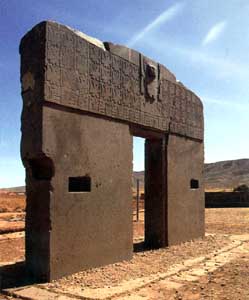
Sun's Door
BOLIVIA: Tiwanaku Empire Ruins |

Sun's Door
"The Bolivian highlands, permanently settled for at least 21,000 years, were part of the culture of Andean South America before the arrival of the Spaniards. The records are fragmentary but suggest that agriculture started about 3000 B.C. and that the production of metal, especially copper, began 1,500 years later.
By 600 B.C., the first great Andean empire had emerged on the high plateau
between the mountains known as the
Altiplano. This empire, the Tiahuanacan, was centered near the southeastern
side of Lake Titicaca and included urban centers around the lake, as well
as enclaves in different ecological zones from the eastern valleys to the
Pacific Coast (see fig. 1). Tiahuanacu was a great center of trade and
religion, and the impact of its culture spread far beyond the boundaries
of present-day Bolivia. Apparently, the Tiahuanacan Empire was established
through colonization rather than through conquest. Its rapid expansion
after 1000 and sudden collapse around 1200 are still poorly understood.
The collapse of Tiahuanacan influence resulted in the rise of seven regional kingdoms of the Aymara, the most powerful states located in the densely populated area around Lake Titicaca. The Aymara, a belligerent people who lived in fortified hilltop towns, had an extraordinary ability to adapt to the unique climatic conditions of the region and increased their food supply through irrigation and the process of freezing and drying crops. By maintaining colonists in the semitropical valleys on the eastern slopes of the Andes and on the Pacific Coast, they were able to produce both tropical and highland crops. Their basic social unit was the ayllu (see Glossary), a kinship group or clan that organized work and distributed land among its members.
The Aymara completely dominated the Uru, another major ethnic group in the pre-Columbian southern Andes. Although the Uru might have preceded the Aymara in the region, by the twelfth century they were poor fishermen and landless workers.
The Aymara, however, were not able to contain the expansion of the Quechua,
the third major ethnic group. After the collapse of the Tiahuanacan Empire,
a Quechua-speaking state emerged in the area around Cuzco (in present-day
Peru).
In the early fifteenth century, the Quechua, who became known as the
Incas when they adopted the name of their rulers, were the most powerful
group in the northern highlands. As the Aymara kingdoms in the south became
weaker in the second half of the fifteenth century, the Incas began to
conquer them.
The Bolivian highlands became known as the Kollasuyo, a densely populated area with great economic and mineral wealth that constituted one of the four administrative units of the Inca Empire. The highest official of the Kollasuyo was responsible only to the Inca (the emperor) and supervised a group of provincial governors, who in turn controlled members of the Aymara nobility."
From US-Library of Congres.
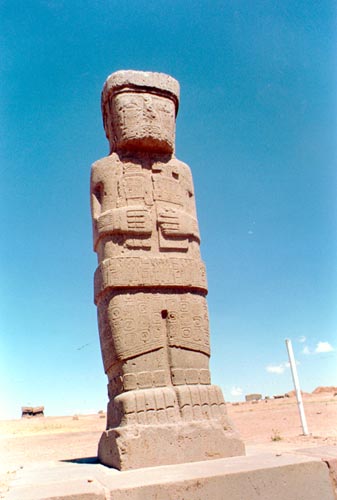
Monolito Ponce, Tiahuanacu
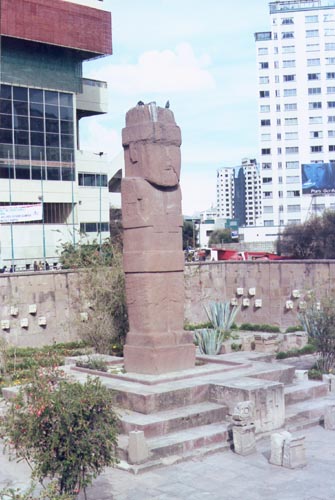
Monolito Benett and Semi-subterranean temple
(Currently in La Paz City)
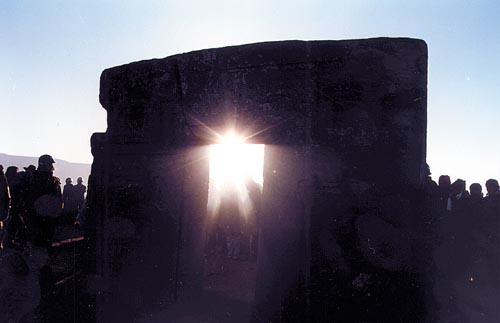
Sun´s Door (Puerta del Sol), Winter solstice
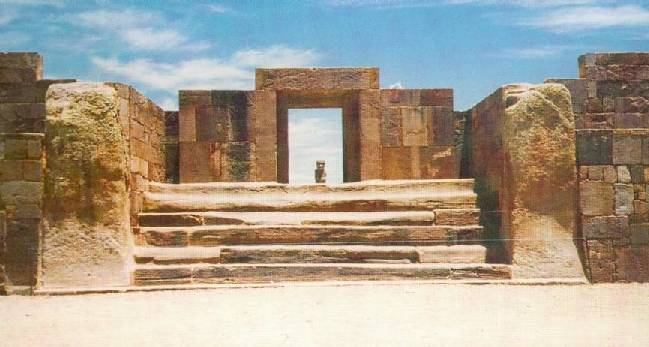
Kalasasaya Temple
(back: Monolito Ponce)
This page was updated on January 1, 2004.